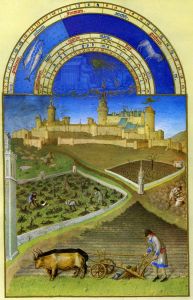Originally posted by Allison D. Reid:
 Warmer March weather meant it was time to finally put most indoor tasks aside and get out into the fields. There weren’t a great variety of tasks associated with March, mainly because preparing the fields for plowing and planting was such an onerous chore that began at dawn and ended at dusk. Getting the spring grain into the ground was one of the most important tasks of the season.
Warmer March weather meant it was time to finally put most indoor tasks aside and get out into the fields. There weren’t a great variety of tasks associated with March, mainly because preparing the fields for plowing and planting was such an onerous chore that began at dawn and ended at dusk. Getting the spring grain into the ground was one of the most important tasks of the season.Medieval farmers generally had a three field system, where each season one of the fields was left unplanted. But leaving it fallow didn’t mean there wasn’t any work involved. The fallow field would have to be plowed several times during the year to keep the weeds under control and at the same time enrich the earth with organic matter. Every time the field was plowed, new weeds would grow, and livestock would be sent out to graze on it, with the added benefit that they would fertilize it with manure as they went.
 Pruning vines and trees continued in March, as did calving. By the end of March, some of the calves were ready to be weaned, which meant milk became available once again. Cows whose calves had been weaned were milked twice per day. The same was true of sheep. Another important food source which returned to the medieval diet in March was eggs. Hens require at least 12 hours of daylight to produce, which meant they began laying around the spring equinox at the end of March, and ceased production around the autumn equinox at the end of September.
Pruning vines and trees continued in March, as did calving. By the end of March, some of the calves were ready to be weaned, which meant milk became available once again. Cows whose calves had been weaned were milked twice per day. The same was true of sheep. Another important food source which returned to the medieval diet in March was eggs. Hens require at least 12 hours of daylight to produce, which meant they began laying around the spring equinox at the end of March, and ceased production around the autumn equinox at the end of September.This week you can also enjoy another episode of “Tales from the Green Valley” which focuses on what daily life would have been like during the month of March. As I watched, I was reminded that even though certain jobs took priority in specific seasons, many of them happened to some degree all year round. In this video, you will see in action some of the tasks that have been mentioned in past Medieval Monday posts, such as threshing and winnowing, milling wheat into flour, sending pigs out to forage, playing games, and brewing ale and beer for every day drinking. You’ll get to see some period recipes being made as well (like what they did with all that dried, salted fish saved up for winter). Again, it’s worth setting aside half an hour to watch this BBC production. It makes for excellent research and really sends you back in time!


No comments:
Post a Comment